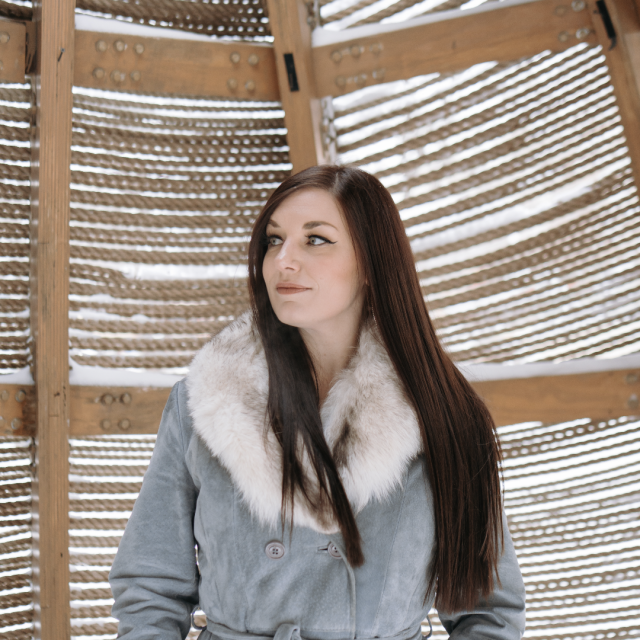Tagged: Facebook
Why We Need Twitter (or Something Like It) More Than Ever
- by Alyson Shane
For myself, and many people that I know, the world feels like an unfamiliar place right now.
The recent election of Donald Trump in the United States, and the apparent rise of white nationalism, anti-feminism, Islamophobia, homophobia, antisemitism, etc. (also known as the "alt right") has many people feeling scared and confused, and a lot of articles, from WIRED to Mashable, have emerged recently about the "echo chamber" that social media, particularly Facebook, has created which has led us to where we are today.
With that in mind, I wanted to discuss some of the ways in which I believe Twitter is actually getting things right in terms of providing a non-insular opportunity for people to express themselves, easily find dissenting viewpoints, and engage with them in conversation.

Before we begin
I know that there are a lot of dissenting views out there about Twitter, and it's usefulness as a social platform. Before I go too much further, let me get these things out of the way:
- Yes, I know that their CEO is wildly unpopular
- Yes, I know they have had issues addressing harassment and hate speech in the past
- Yes, I know that their value has tanked
- Yes, I know they have issues acquiring new users
This post isn't about any of those things.
What I'd like to do is discuss some of the things that make Twitter an important and necessary platform for our society right now, and how it (or something with the features I'm going to highlight) must continue to offer in order to allow for citizen journalism, the sharing of thoughts and ideas, and discussion online.
Hashtags (that people really use)
This morning I got up and read (on Twitter) that the cast of the Broadway musical Hamilton delivered a speech to United States vice-president elect Mike Pence at the end of their show last night. Within a few hours, right-leaning Twitter users took to the social network to start pushing a hashtag called #BoycottHamilton, urging (rather obviously) Trump supporters to boycott the play.
The fact that a hashtag emerged isn't what's important, but what you see when you click on the hashtag is:
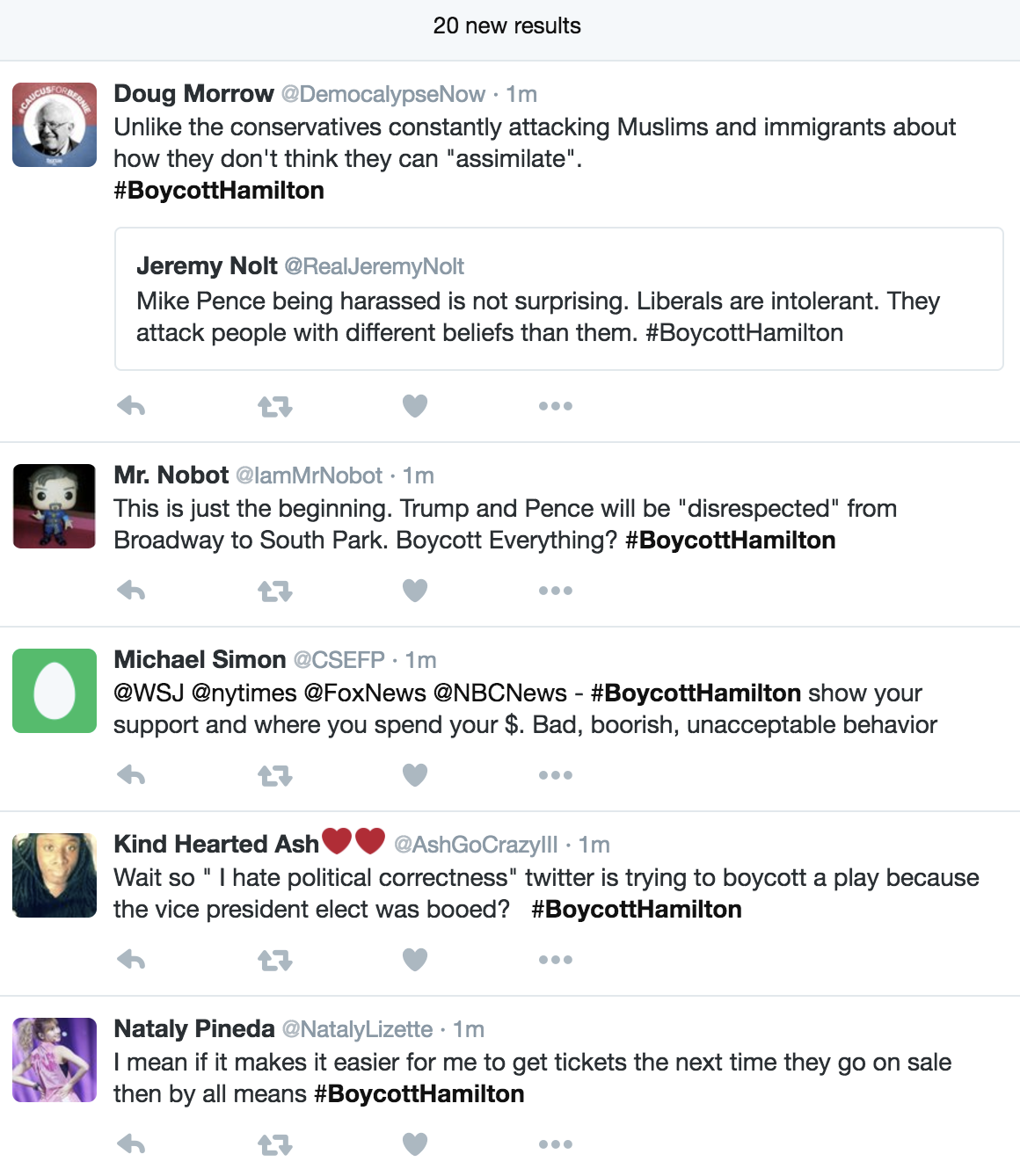
Even in this single snapshot we see a series of diverse opinions. Some don't take it seriously, some are worked up, etc. Not only does a timeline around a hashtag display diverse opinions, but Twitter also offers you this added level of engagement with a hashtag's tweets:
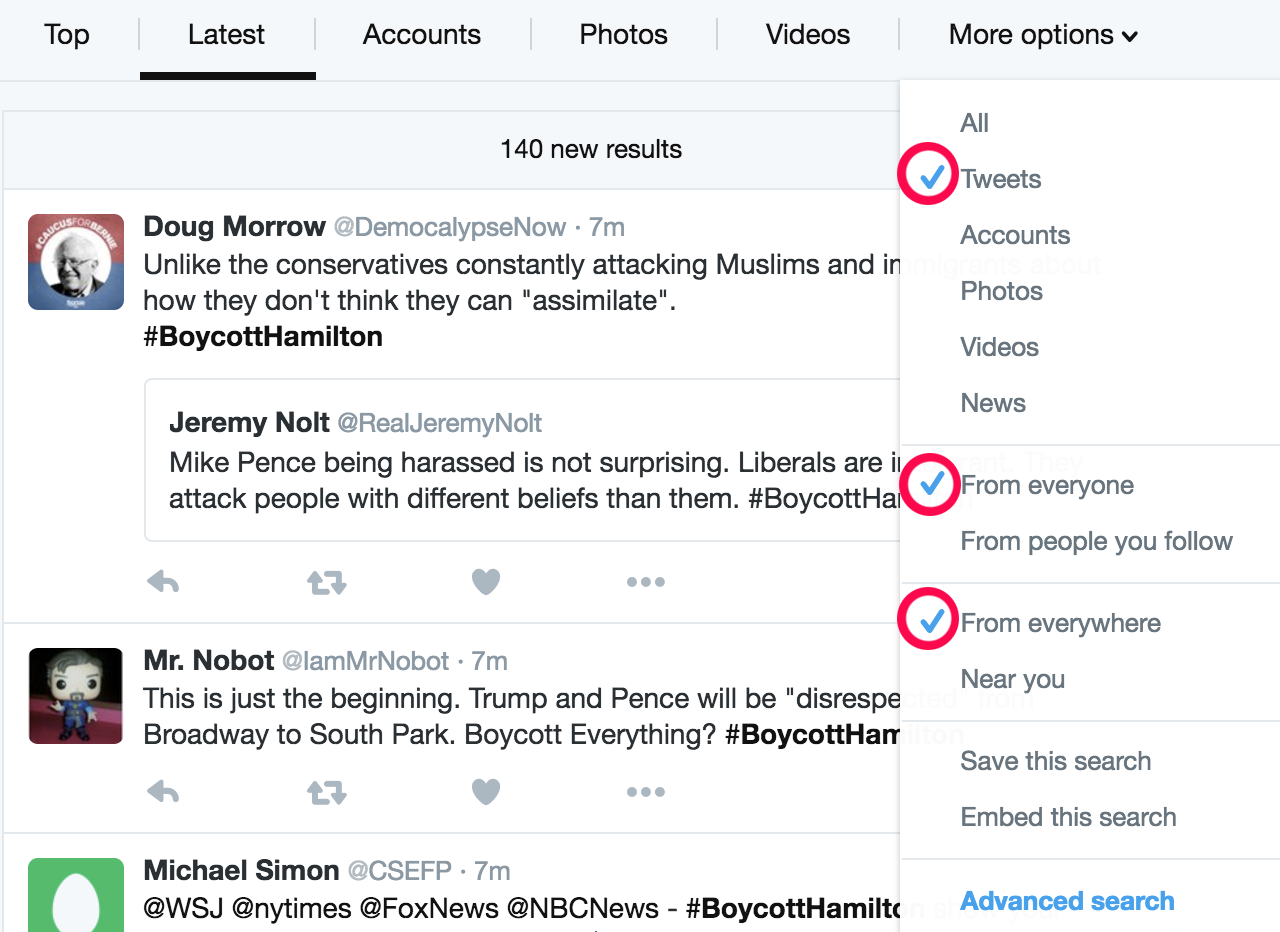
These settings are on by default. This means that in order to find yourself inside a Twitter echo chamber, you literally have to take the necessary steps to insulate yourself against opposing viewpoints.
Compare this to Facebook, which deliberately shows you news items and articles that appeal to you and goes out of their way to make changing those settings a challenge. Yes, hashtags are available to use on Facebook, but according to a 2016 BuzzSumo report, posts without hashtags received more interaction than posts with hashtags. This means that not only are hashtags not popular in Facebook, but that including a hashtag in your post actually lowers the likelihood that someone will engage with it.
So not only is Facebook pushing appealing news at you, but the primary tool at your disposal to find dissenting voices (a hashtag) are rarely used. This means that in order to find different opinions you either need to already be Facebook Friends with someone who disagrees with you, or you have to already subscribe to a Facebook Page or Group where you're likely to hear dissenting views.
But even in that scenario, you still have to actively seek it out, Like, and in some cases apply to join, a Group or Page which espouses views that you disagree with. Then, once you start expressing your opposing viewpoints you encounter the next hurdle: the wall of text. Which brings me to my next point:
Character and post length
Algorithms aside, one of the biggest differences when it comes to hearing opposing viewpoints online, and actually paying attention to them, is that Twitter forces you to be brief, at least in the context of a single tweet.
On Facebook there's no character limit, which means people can (and do) go on ad nauseam to explain their point of view. There's nothing inherently wrong with this, but it highlights the difference that Twitter acts like a conversation, while Facebook acts like a soapbox.
Being on the receiving end of a "Twitter storm" sucks; I can tell you from experience. But it's much easier to process and digest someone else's point of view in 140 characters than digesting (and responding to) several massive paragraphs (or, if you're unlucky, a single monolithic wall of text.)
Tweets, for all their faults, force people to break up their thought process, which provides opportunities for others to interject, respond, and get involved without having to unpack multiple paragraphs of text. I've engaged in debates with people on Twitter over a specific hashtag and more often than not both sides receive support from people who happened to see the conversation, and wanted to participate.
On the flip side, Facebook allows comments to be up to 63,206 characters in length, according to a 2016 HubSpot article. To put that into context: the average book is approximately 500,000 characters, meaning you can fit an entire novel in 9 Facebook status updates.
Just because tweets are shorter doesn't mean that they won't get ignored, or fluffed off, but when a Facebook user replies with a wall of text, a common sign of trolling, it's much easier to dismiss or simply ignore it.
Encouraging conversations
One of the points that I made earlier was about hashtags, and how searching for a hashtag meant that you could easily find differing opinions. It's also important to note that including a hashtag in your tweets also means that other people can easily find you.
Tweeting about a topic like #BlackLivesMatter, #Election2016 or #MAGA (to name just a few) will not only bring like-minded users out of the woodwork, but it's almost guaranteed that someone from the other side of the political spectrum will tweet back at you.
Tweets which include hashtags are 33% more likely to get retweeted than those that don't use them, and this (somewhat older) article from Sysomos which examined over 1.2 billion tweets in two months, which states that "29% of all tweets produced a reaction - a reply or a retweet. Of this group of tweets, 19.3% were retweets and the rest replies."
This 2016 report found that Twitter accounts for 30% of all global social sharing. At 500 million tweets sent each day (or 6,000 tweets every second), that's a lot of replies and retweets, even if Sysomos' 2010 numbers haven't grown since the article was published.
Not only does voicing your opinion on Twitter increase your chances of interacting with someone who disagrees with you, but when a discussion is retweeted, its visibility becomes amplified too. As more users participate, it increases the likelihood that you will run into someone who disagrees with you even more.
Default "public" profiles
Transparency is, in my opinion, the defining feature which makes Twitter such a powerful tool for discussion: when you tweet at someone your reply is completely public.
Unless you go out of your way to change your Twitter profile to "private," your entire tweet history including replies, retweets, quotes, and media will be available for any one whether they are logged in to Twitter or not. And if a tweet is retweeted, even deleting it later won't delete the retweet copy.
Facebook, conversely, was designed to be a more exclusive experience. From day one Facebook's defining feature has been a user's ability to selectively choose who can see what they share, and, for the most part anyway, the conversations you are able to have are limited to the amount of Facebook Friends you've approved, or the number of Groups or Pages you Like or participate in.
While the average Facebook user's Timeline isn't completely private (posts which tag other users, for example, will show up unless otherwise specified) and their comments may be seen if another user's privacy settings are more lax, overall what you say on Facebook isn't immediately available to the public in the same way that Twitter's Timelines are.
Yes, people are can be "outed" if they say something that another user disagrees with, but unless the person is a celebrity, political figure, or person of interest, the average user isn't going to re-share a hateful comment their coworker made and say "I never realized that so-and-so in Accounting was such an antisemite!"
We just don't call each other out in that way on Facebook at a personal level, and on Twitter, we don't really need to, because whatever a user posts is readily available to the world at large.
Easy access to a variety of opinions
Until recently, when we examined a specific historical event or time we had a limited number of sources to draw from. Nowadays, social media allows us to look into the life of the average person and experience, sometimes in real time, what they are experiencing.
Probably the most memorable of these incidents was the Twitter coverage of the protests over the 2009 Iranian election. Foreign media had been banned from reporting, and the stream of live coverage from everyday citizens on the ground led to a request from the U.S. State Department to put off scheduled maintenance which would have caused an outage in Iran during the protests.
Twitter provided the world with access to real-time information about a national crisis, and ever since has become the go-to source for breaking news including weather, political uprisings, and more. But it does more than just give us "on the ground" access to important events; it allows for public scrutiny of the facts, so that while false information will still get around, corrections have the chance of spreading in realtime too.
By using hashtags to discuss a common theme or event, Twitter users are able to contribute to a global and multi-faceted real-time narrative about what's happening in the world that they live in. Clicking on the hashtag they're using will show them a diverse array of opinions on the topic.
Here's another screenshot of some of the 'Live' #BoycottHamilton tweets:
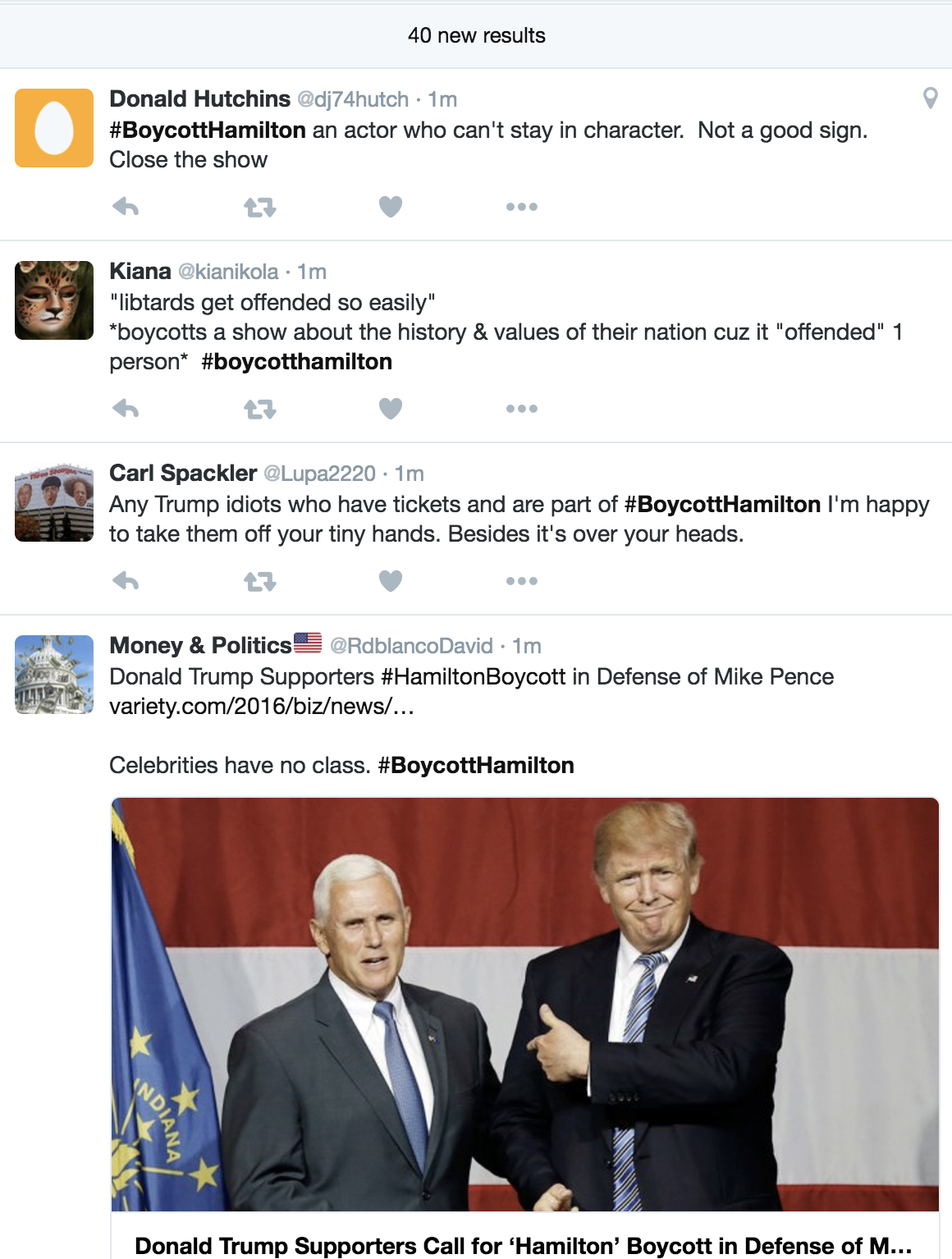
In closing
To be clear: I don't think that Twitter is the perfect platform. It has its share of flaws and issues, and eventually something will come along to replace it (hence the title of this post).
However, I do think that it's important to discuss the elements of the social network which I think make it good, and relevant. Twitter is an important tool for discussion and news, and provides more opportunities for users to engage with people outside of their "echo chamber."
Now, more than ever it seems, we need to be able to hear what other people have to say.
How to Create Facebook Ads That Actually Get Results
- by Alyson Shane
Facebook is the world's largest social network with more than 1 billion worldwide users, and it's an important social network for businesses to be able to connect with their audiences and share their content.
However, recent changes to Facebook's "timeline" feature presents a challenging problem: many businesses depend on Facebook to connect with their audiences and Facebook's organic reach has been steadily declining. In fact, the company recently announced that it would be curating users' timelines to show even less content from Pages (the business equivalent of a Profile) than ever before.
Shock! Panic! Is this the end of Facebook for businesses?!
Well... no, not really. All it means is that we have to start changing our tactics to meet the shifting demands of the social network, which means spending more time to reach the same number of people that we once (easily) reached for free.

Is Facebook still worth it?
For businesses with Facebook Pages this news may leave you feeling frustrated; after all, now you'll reach fewer people when you publish new content than you did previously. However, it's important to note that users who regularly engage with your posts by liking, commenting, and sharing (aka your "hardcore fans") will still see your content on their timeline on a regular basis.
While this shift in timeline content may feel discouraging, it's important to note that Facebook's users continue to increase every year, which means that it's still a growing and powerful network that deserves your time and attention.
With this in mind, there are basically two things you can do to increase visibility:
Encourage users to share your content
I recommend this to everyone I work with; getting users to share your content is an easy (and free!) way to reach a wider audience and encourage people to like and engage with your page. Contests, promotions, and timely, informational content are all ripe for sharing, but creating this content takes time and isn't all that reliable, because it's difficult to predict exactly what will resonate and get shared, and what won't.
So while I work this kind of content into every content calendar I manage, I strongly encourage my clients to consider...
Paid Facebook Advertising
Facebook's page advertising platform is incredibly powerful, and one of the reasons that I love it is that you can reach a large targeted audience on a daily basis very easily.
Let's say for example you want to promote your restaurant's newest dinner feature. You can use Facebook's Ad Manager to target people in your city with upcoming birthdays and anniversaries who like steak, wine, locally-sourced food, and earn an average annual household income of between $75,000 - $100,00.
Facebook Ads allow you to target exactly the kinds of users you want to see your ad, meaning you get you a direct connection with the kinds of people you want to be coming into your restaurant.
This is the biggest benefit from Facebook advertising: instead of creating a one-size-fits-all ad and hoping that it works, you can target users who live in a specific area, or who have already expressed interest in similar products or services to the ones you're selling.
While many people may still feel frustrated with online advertising, they'll still stop and click on a link if it interests them enough.
Getting started
Every business is unique, and their audiences are unique and will respond differently to different messaging and images, and part of effectively using Facebook Ads is simply making the investment and experimenting with different ads to see which ones will resonate best with your target audience.
With that in mind, here are a few things to remember as you start wading into the big, wide (or small and targeted) world of Facebook Advertising:
- Do your research. If you don't know how to create a buyer persona for your business then check out this post on the subject, then get to making those ads. Otherwise, you won't have any idea who you should be targeting, and you'll waste valuable dollars figuring it out.
- Be patient. As I said, generating the kind of long-term sales and click-through rates that most businesses are looking for takes time. Some campaigns will perform wonderfully; some may flop completely, but it's staying committed to it and learning as you go that will generate real results.
- Test extensively. There are lots of ways to reach the same groups of people: where they work, where they went to school, what their interests are, which Pages they like, etc. Experiment with targeting different interests and see what happens!
- Change up your images. I rarely run a Facebook Ad campaign with fewer than three photos because I like being able to compare and see which kinds of images did better. Not only does this help me understand which images resonated better with people, but it also helps me know which images not to use the next time around.
One last thing...
It's important to remember that a single Facebook Ad won't produce brilliant results overnight. Like social media, blogging, or any other form of advertising (online or otherwise) these things take time. It's a much better long-term business strategy to allocate a monthly "ad spend" budget, and cycle through and try different kinds of ads to see what works.
However, if you can tap into your audience's needs and interests then Facebook Advertising is one of the most powerful weapons in your marketing arsenal, so why not give it a try? (and if you need a hand, drop me a line - I'm happy to help!)
Do you have any tips for Facebook Advertising? Tell me in the comments!
The Power of the Hashtag
- by Alyson Shane
In the last few years the use of the "hashtag" (the # symbol - previously called the 'Pound Sign' if you're a fossil like me and used a push-tone phone growing up) has exploded in popularity. Unless you live under a rock you've likely been bombarded with the hashtag symbol everywhere - on commercials, billboards, on social media, on clothes... these days the "hashtag" is one of the most pervasive and powerful symbols of our digital age.
Despite seeing hashtags everywhere, most people don't understand their importance or how to harness their power to help them convey their message across social media platforms. A simple hashtag can improve your reach, drive brand recognition, and easily engage in large-scale conversations online.

#Why?
If you're a business owner or someone hoping to expand their social media influence, a hashtag should be an important part of your social media strategy. This is because a fitting hashtag can help drive brand recognition, drive customer loyalty, and help spread the word about your idea or product.
A hashtag instantly connects a social media post to a group of others about the same topic, and connects the person sharing it (you) with other people talking about the same topic in real-time.
What this means is that you can include a simple hashtag in your social media post and immediately have it seen by anyone else looking for that hashtag. Here's an example using Twitter:
Above is a tweet that I just created which includes the #SocialMedia hashtag. When I tweet something that includes a hashtag, the hashtag works like a link which allows people to click on it and find other tweets relating to the same subject.
When I click through on the # link Twitter takes me to a page filled with other tweets which include a "#SocialMedia" tag. The "live" feed (people using it in real-time) looks like this:
As we can see, my #SocialMedia hashtag allows me to connect with other people who are tweeting about the same subject, and for others to find my tweet as well. Twitter also offers search options to refine what you want to see from that topic.
Hashtags first started to become commonplace on Twitter as a way to link ideas and conversations in the way that I just described, but other social platforms like Facebook and Instagram have also adopted using them as well.
#How
Even if you know why a hashtag is important, it isn't going to do you much good if you don't know how to use it effectively. In fact, when misused you can actually drive people away from your message because too many hashtags feels spammy (more on that in a second.)
Here's are some ground rules for making sure you're using hashtags to their full usefulness:
- Use the hashtag (#) before relevant words or phrases to categorize posts and help them show up in a search (like in my previous example).
- A hashtag can be included anywhere in the message - they don't have to be stuck at the beginning or at the end if you can work them into the body of your message.
- A hashtag won't appear in a search if your profiles are protected or private.
#Etiquette
Don't #spam #with #hashtags.
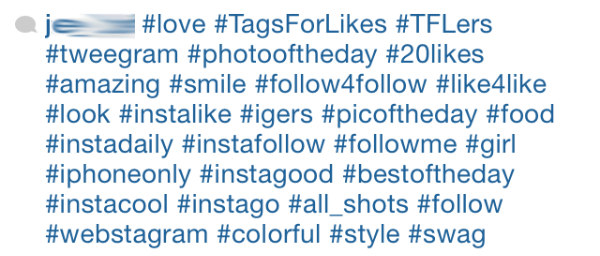
(via Google. I have no idea who this poor soul is)
Don't over-tag a single post. Twitter's best practices recommend no more than two per tweet, and in addition to being visually unappealing it also dilutes your message. Using too many hashtags dilutes the meaning of your message because you're trying to appeal to too many ideas at once.
An exception to this rule is Instagram, in which photos with at least eleven (yeah, 11!) hashtags get the most interaction. This is because Instagram doesn't have a character limit for captions on their photos, and because hashtags are the easiest way for its communities to connect with one another
The trick do doing this effectively, however, isn't to include a million hashtags in your original photo post, but rather to include a comment with your wall of hashtags afterward. This ensures that if you're sharing your photo on other social platforms the people seeing it there aren't bombarded with a dozen messy-looking hashtags. That way you're still able to connect with your Insta-communities, but are also saving some face on any other social networks your photos might be sharing to.
What can you do?
Pick a specific hashtag. If you want to start using hashtags to raise awareness for your product, brand or project, pick a specific hashtag and use it exclusively, or with one other hashtag in the body of your post. Make it unique, relevant to what you're talking about and easy to remember.
Start a Twitter Chat. If you're active on Twitter, another great option is to start Twitter chats using a hashtag specific to the theme you want to discuss. These chats operate like live Q&A's on Twitter which are organized around a specific hashtag. For instance, I participate in a Twitter conversation with other Canadian bloggers every week called #blogchatca - the hashtag is easy to include and remember, and allows me to find other people participating in the conversation and respond to them. By including the hashtag #blogchatca I know we're all participating in the same conversation.
Pick something obvious. Make sure that your hashtag is short, easy to remember, and (if possible) unique to whatever you're discussing. For example, this past weekend I participated in a game jam where the official hashtag was #GameJam. This is great because it's easy to remember and find, but it's a pretty widely-used hashtag because many game jams happen at the same time. As a result, many people tweeting about the game jam I attended started using #PegJam to indicate that they were at a game jam in (you guessed it) Winnipeg. This way everyone could find each other easily and see what others were sharing and discussing.
Do you have any tips on hashtag use? Anything you'd avoid doing? I'd love to hear your thoughts!
7 Steps to Grow Your Social Influence
- by Alyson Shane
Back in the days of yore (read: pre-social media times) most of what we did in our non-work hours stayed that way. Our professional and personal lives rarely mixed.
These days, those lines keeping parts of our lives separate have begun to blur, and we are constantly Tweeting, Snapchatting, posting, watching, sharing... you name it, we're likely doing it in one form or another online. While this means that we have the ability to be more social, it also has larger implications for how we are percieved by our peers, potential employers, and clients online as well.
Whether or not we would like to admit is, how we act online plays a big part in contributing to our professional reputations. People will judge based on the sum total of what you're shared online, and the internet never forgets - even if you delete what you've posted, it's still out there.
With that in mind, here are a few tricks that I've picked up to manage my activities online and to use my social media profiles to grow my influence:
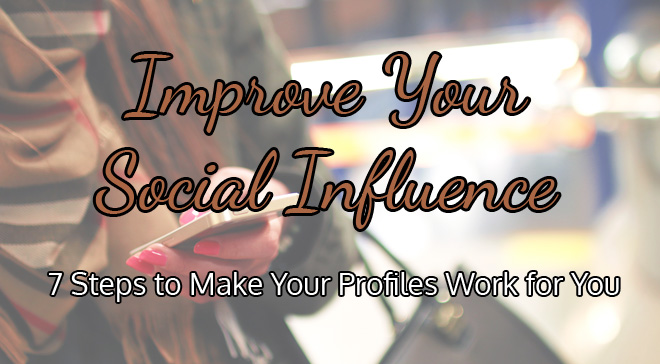
1. Create and Curate Your Profiles
Are the social platforms that you hang out on the ones that are most beneficial to you and your professional goals? It's likely that you're already on Facebook, Twitter, and LinkedIn, but if you're in the food, travel, fashion or lifestyle business, you should also have an active Instagram and Pinterest account, with relevant and up-to-date profiles on each.
The trick to using all of these platforms is to present yourself as someone interesting who knows how to use each of their social platforms in the best way possible. Edit your profiles to fit with your goals for each social platform and include links, if possible, as well as a well-taken photograph of yourself.
2. Share Your Content
Facebook, Twitter and Instagram operate essentially as "show and tell" platforms for content, so if you just knitted a great kitty sweater for your Etsy store or wrote a terrific blog post reviewing all the Air BnB locations in Thailand, share it and show your networks your skills.
In particular, content that educates, entertains, or encourages people will recieve a better reception than something which is self-serving or pitches a product. For example, if every other post is a plea for someone to buy your book, it's more likely that they will start ignoring you than your post will suddenly inspire them to log into Amazon.
3. Be Nice
In order for people to care about you, you have to care about them. Be genuinely interested in what others in your community or profession are doing, and don't hesitate to share their successes across your networks.When you are actively sharing and being interested in other people it will encourage them to do the same for you, because you are demonstrating not only that you're interested in them, but that you are willing to help them share their successes by showcasing or congratulating them on your network for everyone there to see. At the end of the day, people want to see nice people succeed, and the quickest way to success is to actively be nice to everyone you meet.
4. Be a Part of a Community
Social media is social first and media second. What I mean by this is make sure that you're using social media to build relationships, not just to broadcast your successes or thoughts.
For example, every Tuesday morning on the way in to work I participate in #blogchatca, a (you guessed it) Twitter conversation about blogging. I'm also a part of Kyla Roma's Daring Creative facebook group, and participate in the monthly #DaringCreative twitter chats she hosts as well. Being a part of these communities not only expands my network to people that I might not have otherwise been able to connect with, but also allows me to develop relationships with people over a shared interest and connection
5. Be Generous with Your Knowledge
One of the amazing things about digital communities is the amount of knowledge that has become available as a result of sharing online. I've found that in a lot of circles this has led to a "pay it forward" model of sharing information - that is, that openly giving and sharing your knowledge will pay off for you in the end.
Generously share news, knowledge, tips or other pieces of information that you think will help others achieve their goals. This not only helps others, but also works to build your social profile as someone who now only knows what they're talking about, but is confident enough in that knowledge to be willing to help others learn, as well.
6. Be Consistent
Being consistent means committing to a certain schedule of publishing and sharing content regardless of how you feel. We all have slumps and bad days (and hey, even I take a break from Twitter if my day is jam-packed) but what matters is that over the long-term you have a consistent presence online.
This not only means posting and sharing content, but also responding to people who contact you and having the discipline to do so in a way that is in line with your persona. Eg: don't use excessive offensive language, don't snap at or belittle people because you're having a bad day, etc.
Which brings me to my next point:
7. Keep Negative Thoughts Private
Venting online, "vaguebooking" or "vague-tweeting" (posting passive-aggressive stuff without stating who you are directing it at), etc is not okay. Don't do it.
If you've been online for any length of time you've probably engaged in this sort of behaviour before (it's okay, I have, too, once upon a time) but it's time to grow up and start behaving like adults online.
The reason behind it is this: you never know who is reading your content. You might think that your Facebook is friends-only, but how do you know that a friend-of-a-friend won't see an inside joke and take offense? Or that slanderous thing you Tweeted about a co-worker might be a little too specific, and you might find yourself out of a job. Better to be safe than sorry.
In addition to potentially landing you in hot water, having a negative online persona has long-lasting consequences: people will think of your negative, snarky comments before they think of a helpful link that you posted, so even if you're generally positive online a bad day or a slew of passive-aggressive comments can destroy the online reputation you've worked so hard at building.
There are a multitude of ways in which your bad attitude could backfire, so it's safest to keep it offline completely (or, focus on being more positive.)
These are just a few steps that you can take to start expanding your social reach and growing your influence online. Do you have any suggestions? I'd love to hear them!
5 Steps to a Better Social Media Profile
- by Alyson Shane
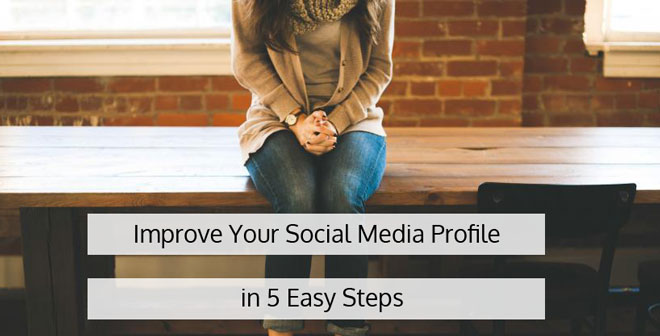
Whether it's on Facebook, Twitter, Pinterest or LinkedIn, it's pretty much guaranteed that your profile on one of these websites will be one of the first things that someone Googling your name is going to come across.
As such, making sure that these profiles are up-to-date is key to attracting new business, gaining followers and (let's be honest) making an impact online.
Luckily it's pretty easy to make sure your profile is up to snuff!
Let's Get Started
1. Never Leave a Profile Empty
People need to know more about you than just your name. Pop in a short bio, a few links to work you've done, or a quote you love. Anything is better than leaving it blank!
2. Use Keywords
For best SEO results, include some keywords into your bio. For example, if you're a mommy blogger who wants to work with family-oriented brands, then state "mommy blogger" in your profile. Here's mine on Twitter:
Marketing Manager by day. Blogs at http://www.alysonshane.com and does freelance copywriting & content marketing by night. Is the Queen of the Internet.
and on Linkedin:
Alyson Shane: Content Marketing & Social Media, Blogging, Speaking
3. Reference your work
Do you run a blog? Are you a regular contributor to a website? Are you a brand ambassador? Make sure to mention it in your bio for maximum credibility!
4. Show some sass
If the space allows, try not to just be matter-of-fact. Add a quote or interesting fact about you at the end of your profile. For instance, my Twitter profile states that I'm the Queen of the Internet.
5. Include a photo
Include a photo of your lovely face! People want to know that they're connecting with a real person, not just an egg on Twitter or a blank face on Facebook. Profiles that don't have real photos scream "spam account" and you don't want to be mistaken for one of those, do you?
What about you?
Did you have any profiles that were blank? What changes did you make?
Talkin' Tech: Facebook at Work
- by Alyson Shane
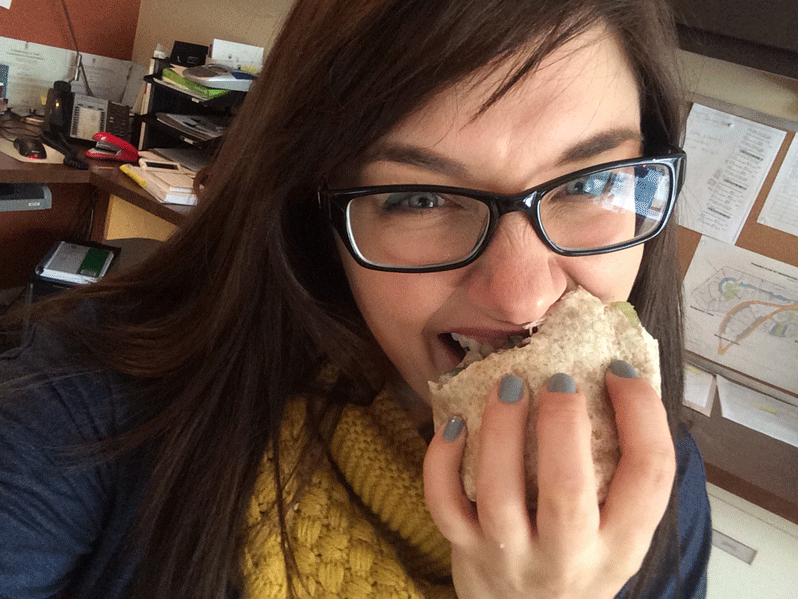
Back at the office and real life after three awful days of the flu. Feels good to be eating solids again! Currently inhaling a turkey & cranberry wrap from Diversity Foods. Amazing.
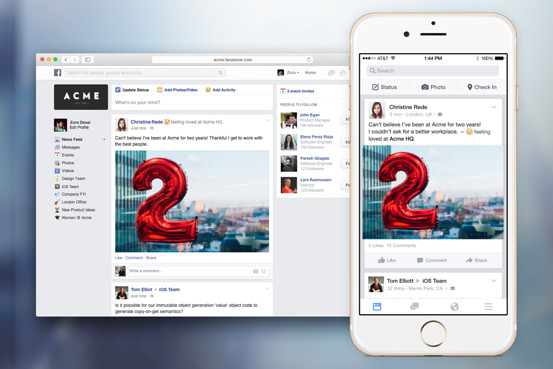
Been reading heaps today about Facebook's new Facebook at Work App but am unsure about how I feel about it. I use Google Drive both personally and professionally and am really happy with it.
Plus Facebook at Work doesn't offer document sharing between profiles or in groups (yet) which is a big dealbreaker for me.
It's smart of Facebook to start really targeting a more professional (read: adult) audience since from everything I've read young people aren't really gravitating to it and using it as their main social platform anymore, but the idea of having separate work/personal Facebook accounts seems a bit cumbersome IMO.
Also, there's already everyone's favourite (sigh) professional network, LinkedIn, and I already consider updating my LinkedIn to be enough of a hassle that yet another profile to manage and toggle between grates at my nerves a bit.
Though Facebook seems to be focusing on chat and Groups and less on showcasing online resumes, LinkedIn is apparently considering integrating a chat feature sometime in the future and is going to be releasing tools to make it easier to connect with co-workers this quarter, so it looks like it might be moving towards a more social experience than just trolling through other people's work histories.
I don't know, while the whole " no ads & no tracking user data" is appealing, it would take a lot for me to move away from Google Drive, Skype and the myriad of other social networks that I already frequent for my professional work.
It doesn't really matter anyway, because it's not available for us plebes at the moment and Facebook is still testing well into the forseable future.
Right now, though? I'm happy keeping my Facebook use the way it is: as a distraction from my work, not as an integral part of it.
What about you?
